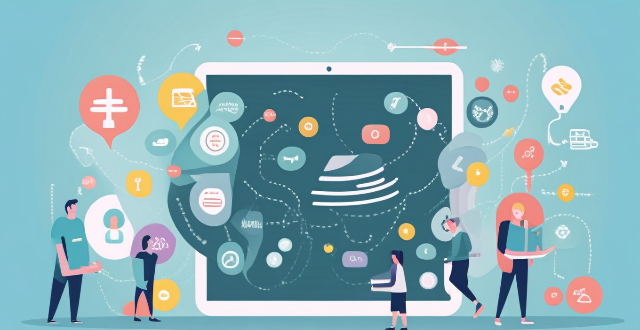Learning Article

How do technology-based learning tools contribute to innovative teaching practices ?
This article discusses the role of technology-based learning tools in innovative teaching practices. It highlights how these tools can enhance student engagement, facilitate collaboration and communication, provide access to global resources, and enhance assessment and feedback mechanisms. The article also emphasizes the importance of personalized learning experiences and gamification techniques in making education more engaging and enjoyable for students. Overall, the article suggests that technology-based learning tools have the potential to revolutionize education by making it more interactive, accessible, and effective.

What are the best language learning apps for beginners ?
The article provides a summary of the best language learning apps for beginners. These apps offer interactive lessons, gamified approaches, personalized lessons based on proficiency levels, speech recognition features, and community features to connect with other learners and native speakers. Some of these apps are free to use, while others require a paid subscription for full access. The apps discussed in the article include Duolingo, Babbel, Rosetta Stone, Memrise, and Busuu.

Are there any free platforms for language learning ?
Language learning has become more accessible than ever before, thanks to the internet. There are numerous free platforms available for those who want to learn a new language or improve their existing skills. In this article, we will explore some of the best free language learning platforms available.

How does educational psychology impact student learning ?
Educational psychology plays a crucial role in understanding and enhancing student learning. It helps educators understand cognitive development, enhance motivation and engagement, promote social-emotional learning, address diverse learning needs, and evaluate teaching strategies and interventions. By incorporating insights from educational psychology into their practice, teachers can create a more effective and supportive learning environment for all students.

How do online learning platforms enhance student engagement and performance ?
The article discusses how online learning platforms enhance student engagement and performance. It mentions personalized learning experiences, interactive content and multimedia, collaboration and communication tools, gamification and rewards, flexibility and convenience, and immediate feedback and support as key features of these platforms that contribute to improved student outcomes.

How does lifelong learning impact career development ?
Lifelong learning is a continuous process of acquiring new knowledge and skills that can significantly impact career development. It enhances skills, adaptability, creativity, personal growth, networking opportunities, and career longevity. By engaging in lifelong learning, individuals can stay relevant in their professions, adapt to changing job requirements, and increase their chances of career success.

What are some effective strategies for lifelong learning ?
Lifelong learning is crucial for personal growth and adaptability. Effective strategies include setting clear goals, creating a learning plan, leveraging technology, practicing active learning, seeking mentorship, and embracing failure for continuous improvement.

Can you recommend any good online learning resources for language learning ?
Here are some good online learning resources for language learning: Duolingo, Rosetta Stone, Memrise, Babbel, italki, Lingoda, Busuu, Coursera, Edx, and FluentU. These platforms offer courses in various languages and use different approaches to teaching, such as interactive lessons, immersive experiences, flashcards, conversation skills, one-on-one tutoring, and real-world videos.

How can I improve my language learning speed ?
The article provides tips on how to improve language learning speed, including practicing consistently, immersing oneself in the language, active learning, practicing speaking and writing, using technology, and setting achievable goals.

How can I develop a habit of lifelong learning ?
Lifelong learning is crucial for staying relevant and competitive. To develop this habit, set clear goals, create a learning plan, make learning part of your daily routine, embrace challenges, stay curious, connect with others, reflect on your journey, and continuously update your skills.

What are the best online learning resources for beginners ?
The text provides a list of online learning resources for beginners, including Khan Academy, Coursera, edX, Udemy, Codecademy, Duolingo, Skillshare, and LinkedIn Learning. Each resource offers courses in various subjects, from computer science to language learning, and many are free or have affordable options available.

How can employers encourage and support lifelong learning among employees ?
Employers can support lifelong learning by offering resources, encouraging participation in training programs, providing opportunities for career development, and creating a collaborative learning environment.

Are there any good online learning resources for language learning ?
Good online learning resources for language learning include Duolingo, Memrise, Rosetta Stone, Babbel, and Busuu. Each platform has its unique features and strengths, such as interactive lessons, memory techniques, immersive experiences, conversational focus, and community support. These resources can help learners achieve fluency in their target language by providing engaging and effective ways to learn vocabulary, grammar, pronunciation, and cultural insights.

What are the best online resources for learning programming ?
The article discusses various online resources available for learning programming. It categorizes these resources into free tutorials, paid courses, and practice projects. The free tutorials include Codecademy, Coursera, edX, and Khan Academy, which offer interactive exercises, video tutorials, and quizzes to help learners practice their skills. Paid courses are offered by Udemy, Treehouse, Pluralsight, and Lynda/LinkedIn Learning, providing video tutorials, interactive exercises, and assessments. Practice projects can be found on GitHub, HackerRank, LeetCode, and Project Euler, where learners can work on real-world problems and improve their problem-solving skills. Overall, the article provides a comprehensive list of resources for those looking to learn programming online.

Where can I find comprehensive online learning resources for business management ?
The article discusses various online learning platforms that offer comprehensive resources for business management. These include Coursera, Udemy, edX, Khan Academy, and LinkedIn Learning. The courses provided by these platforms cover a wide range of topics, such as strategy formulation, financial management, human resource management, and marketing. Some of the popular courses mentioned are Introduction to Marketing by Northwestern University on Coursera, Business Finance for Non-Finance Managers on Udemy, and Strategy and Innovation in the New Economy by Stanford University on edX. The article emphasizes that these platforms offer courses suitable for learners of all levels and can help individuals acquire the necessary knowledge and skills to become successful business managers.

How does exercise impact memory and learning ?
Exercise has a positive impact on memory and learning by increasing blood flow, releasing neurotrophic factors, reducing inflammation, alleviating stress, and improving sleep quality. Incorporating physical activity into daily routine can enhance cognitive functions.

What are some benefits of using online learning resources compared to traditional classroom learning ?
Online learning resources offer advantages over traditional classroom learning, including flexibility and convenience, cost savings, personalized learning experiences, exposure to diverse cultures, and development of technology skills.

Are there any free language learning apps that are worth using ?
There are many free language learning apps available that can help you on your journey to fluency. Some of the best ones include Duolingo, Memrise, Busuu, Rosetta Stone, and Tandem. Each app offers unique features and benefits, such as gamified learning experiences, memorization techniques, social platforms for conversation practice, and immersive environments with no translation needed. Whether you prefer interactive games or connecting with native speakers, there is an app out there that can help you achieve your language learning goals.

Are there any language learning apps specifically designed for children or teenagers ?
This article explores some of the best language learning apps specifically designed for children and teenagers, including Duolingo, Babbel, Rosetta Stone, Memrise, and Busuu. Each app offers unique features to make language learning fun, engaging, and interactive for young learners. Whether it's gamified learning, conversation practice with native speakers, or immersive approaches to language learning, these apps provide a variety of options for children and teenagers to improve their language skills.

How can parents and teachers effectively collaborate to support student learning ?
Effective parent-teacher collaboration requires open communication, shared goals, consistent expectations, and supportive resources. By working together, parents and teachers can create a positive learning environment that fosters academic success and personal growth for students.

What are the top iPhone apps for learning new languages ?
The article discusses the top iPhone apps for learning new languages. It mentions six different language learning apps, each with its own unique features and benefits. The first app is Duolingo, which offers courses in over 40 different languages and uses a game-like interface to make learning fun and engaging. The second app is Babbel, which focuses on practical conversation skills and offers courses in 14 different languages. The third app is Rosetta Stone, which offers courses in over 30 different languages and uses an immersive learning approach with no translations or explanations. The fourth app is Memrise, which uses mnemonics and visual cues to help users remember new words and phrases. The fifth app is Busuu, which emphasizes conversation practice and feedback from native speakers. The sixth app is Tandem, which connects users with native speakers of the language they want to learn through private chat rooms and voice/video calls. Overall, these apps offer a variety of approaches to language learning and can help users achieve their language learning goals.

What is lifelong learning and why is it important ?
Lifelong learning is the continuous process of acquiring new knowledge, skills, and attitudes throughout one's life. It is important for personal development, professional growth, social contribution, economic benefits, health and well-being, and global citizenship. To embrace lifelong learning, individuals can set learning goals, create a learning plan, seek out opportunities, stay curious, reflect on their learning, and share their knowledge with others.

What are some effective techniques for memorizing grammar rules ?
The article outlines various techniques for memorizing grammar rules effectively. It suggests methods such as repetition, using mnemonic devices, visualization, practice, teaching others, contextual learning, and taking regular breaks. Each technique is explained with examples and tips to make the learning process easier and more enjoyable. The article emphasizes the importance of consistency and patience in mastering grammar rules.

What strategies can help children stay motivated during home learning ?
In conclusion, keeping children motivated during home learning requires a combination of strategies such as setting clear goals, providing feedback and recognition, creating a supportive environment, using technology wisely, and encouraging self-directed learning. By implementing these strategies, parents and educators can help children stay engaged and focused during home learning sessions.

What role do educational institutions play in promoting lifelong learning ?
Educational institutions promote lifelong learning by encouraging a love for learning, providing access to educational resources, offering continuing education opportunities, and fostering collaboration and partnerships.

What are effective home teaching strategies for children with learning disabilities ?
Effective home teaching strategies for children with learning disabilities include identifying the child's learning style, using multisensory approaches, breaking down tasks into smaller steps, using repetition and practice, providing positive reinforcement, and creating a supportive environment. These strategies can help parents help their children overcome challenges and achieve success in their academic endeavors.

How do I start learning golf ?
Golf is a popular sport that can be enjoyed by people of all ages and skill levels. If you're interested in learning how to play golf, here are some steps to help you get started: 1. Understand the basics of golf, including the rules and etiquette. 2. Choose the right equipment, such as a set of beginner-friendly clubs. 3. Take lessons with a PGA professional for personalized instruction. 4. Practice regularly at a driving range, putting green, or chipping area. 5. Play on an actual golf course once you've gained confidence from practicing. 6. Join a golf community to enhance your learning experience and meet other players. 7. Stay patient and have fun while enjoying the process of learning and playing golf.

How does technology facilitate lifelong learning ?
Technology has revolutionized education, making it more accessible, interactive, and personalized. It facilitates lifelong learning through online resources, digital libraries, simulation software, gamification, adaptive platforms, mobile learning, social media groups, online workshops, instant feedback, cost efficiency, and globalization of education. Technology offers a wealth of benefits for learners of all ages and backgrounds.

What are the benefits of using a learning management system (LMS) ?
The article discusses the advantages of using a Learning Management System (LMS) in education and training. The benefits include improved accessibility and convenience, personalized learning experiences, efficient course management, collaboration and community building, data-driven decision making, and cost savings. LMSs centralize content, enable self-paced learning, offer flexible scheduling, incorporate adaptive learning technologies, track progress, and gamify the learning process to make it more engaging. They also automate administrative tasks, scale efficiently, integrate with other tools, facilitate discussions and group projects, support live interactions, collect analytics and reporting data, issue digital certificates, and allow for continuous improvement. Additionally, LMSs reduce travel expenses, promote resource efficiency, and enable scaling without additional costs. Overall, an LMS is a powerful tool for modern education and training initiatives.

What are the benefits of using a remote education platform for learning ?
Using a remote education platform for learning offers numerous benefits that enhance the overall learning experience, including flexibility and convenience, personalized learning, collaboration opportunities, cost savings, access to quality education, improved learning outcomes, and environmental sustainability.